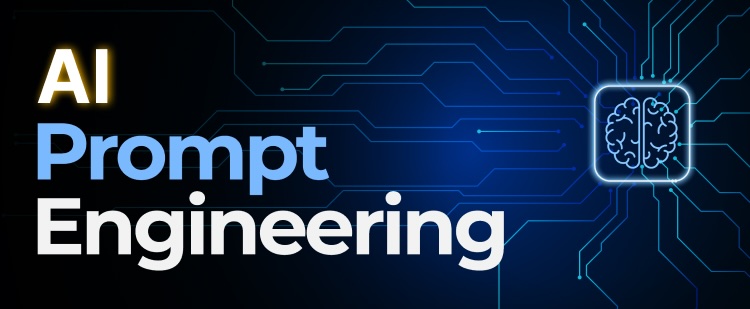By ATS Staff - June 9th, 2025
Artificial Intelligence LLMs Machine Learning Software Development
Introduction
As artificial intelligence (AI) becomes more advanced, the way we interact with it plays a crucial role in getting the best results. Prompt engineering is the practice of crafting effective inputs (prompts) to guide AI models like ChatGPT, Gemini, and Copilot toward desired outputs. Whether you're a developer, content creator, or business professional, mastering prompt engineering can significantly enhance your productivity and AI interactions.
What is Prompt Engineering?
Prompt engineering involves designing and refining input instructions to optimize AI responses. Since large language models (LLMs) generate text based on patterns in their training data, the way you phrase a request can drastically alter the output.
Why Does It Matter?
- Better Accuracy – Well-structured prompts reduce irrelevant or incorrect answers.
- Efficiency – Clear instructions save time by reducing the need for follow-up corrections.
- Customization – Tailored prompts help generate specialized outputs (e.g., code, marketing copy, summaries).
Key Techniques in Prompt Engineering
1. Be Clear and Specific
Vague prompts lead to vague answers. Instead of:
❌ "Tell me about AI."
✅ "Explain how generative AI works in simple terms, with three key points."
2. Provide Context
AI performs better with background information. Example:
❌ "Write a summary."
✅ "Summarize the key takeaways from the latest IPCC climate report in 200 words for a business audience."
3. Use Step-by-Step Instructions
Breaking down complex requests improves results:
❌ "Write a Python script."
✅ "Write a Python script that scrapes news headlines from BBC.com and saves them in a CSV file. Use BeautifulSoup and requests."
4. Set the Format
Specify if you want bullet points, tables, or code:
❌ "List some healthy foods."
✅ "List 10 high-protein vegetarian foods in a markdown table with columns: Food, Protein per 100g, and Calories."
5. Use Examples (Few-Shot Prompting)
Providing samples helps AI mimic the desired style:
❌ "Write a poem."
✅ "Write a short poem in the style of Robert Frost about autumn. Example: 'The woods are lovely, dark and deep…'"
6. Adjust Tone and Style
Guide the AI’s voice to match your needs:
❌ "Explain blockchain."
✅ "Explain blockchain like I'm a 10-year-old, using simple analogies."
7. Iterative Refinement
If the first response isn’t perfect, refine your prompt:
- "Make it shorter."
- "Explain in more technical terms."
- "Give me three alternative versions."
Advanced Prompt Engineering Methods
- Chain-of-Thought (CoT) Prompting – Encourages AI to "think step by step" for complex reasoning.
- Role-Playing – Assign a persona (e.g., "Act as a financial advisor…").
- Negative Prompting – Specify what to exclude (e.g., "Don’t mention politics.").
Applications of Prompt Engineering
- Content Creation – Blogs, social media posts, scripts.
- Coding Assistance – Debugging, generating scripts, documentation.
- Customer Support – Automated responses with consistent tone.
- Data Analysis – Summarizing reports, extracting insights.
Challenges & Limitations
- Over-reliance on AI – Poor prompts can lead to misinformation.
- Bias & Ethical Concerns – AI may reflect biases in training data.
- Context Window Limits – Long prompts may confuse the model.
Future of Prompt Engineering
As AI evolves, prompt engineering will become more intuitive, possibly integrating:
- Auto-optimization – AI suggesting better prompts.
- Multimodal Prompts – Combining text, images, and voice.
- Personalized AI Assistants – Learning user preferences over time.
Conclusion
Prompt engineering is a powerful skill that bridges human intention and AI capability. By mastering techniques like clarity, context, and iteration, users can unlock the full potential of AI tools. As technology advances, those who refine their prompting strategies will stay ahead in the AI-driven world.
Popular Categories
Agile 2 Android 2 Artificial Intelligence 49 Blockchain 2 Cloud Storage 3 Code Editors 2 Computer Languages 11 Cybersecurity 8 Data Science 14 Database 5 Digital Marketing 3 Ecommerce 3 Email Server 2 Finance 2 Google 6 HTML-CSS 2 Industries 6 Infrastructure 2 iOS 3 Javascript 5 Latest Technologies 41 Linux 5 LLMs 11 Machine Learning 32 Mobile 3 MySQL 2 Operating Systems 3 PHP 2 Project Management 3 Python Programming 25 SEO - AEO 5 Software Development 43 Software Testing 3 Web Server 6 Work Ethics 2